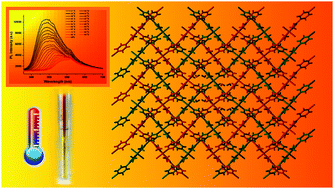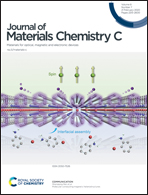A reversible thermo-responsive 2D Zn(ii) coordination polymer as a potential self-referenced luminescent thermometer†
Abstract
A convenient, fast, and accurate temperature detection method is highly desirable in many biochemical processes and scientific research. Luminescence thermometry is one of the most currently studied approaches among the non-contact and non-invasive thermometry techniques. Here, we present an intrinsic energy-based luminescent thermometer based on a stimuli-responsive coordination polymer, [ZnL2]n·nH2O (H2L = 2,3-butanedionebisisonicotinylhydrazone). The temperature-dependent photophysical characteristic reveals that the thermochromic luminescence in the range 40–90 °C can be switched reversibly from yellow to red in an ambient atmosphere, thereby achieving the non-destructive sensing of temperature. Moreover, the material exhibits a linear relationship between wavelength/intensity and the absolute temperature in a wide range, thus presenting a rare solid-state luminescent thermometer based on both photoemission energy and intensity. The crystal structure reveals a 2D layer-structured framework, characterized by an unusual trigonal prismatic Zn center. The reversible thermochromic behavior is mainly attributed to the change in the coordination environment of Zn2+ ions during the dehydration/hydration process. The rapid response (less than 5 s), good reversibility and solvent-free procedure make the Zn(II) coordination polymer an exceptional thermo-responsive material for use in temperature monitoring devices.



 Please wait while we load your content...
Please wait while we load your content...